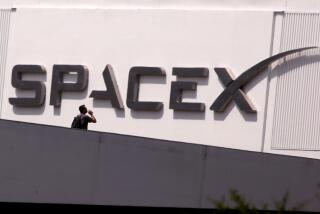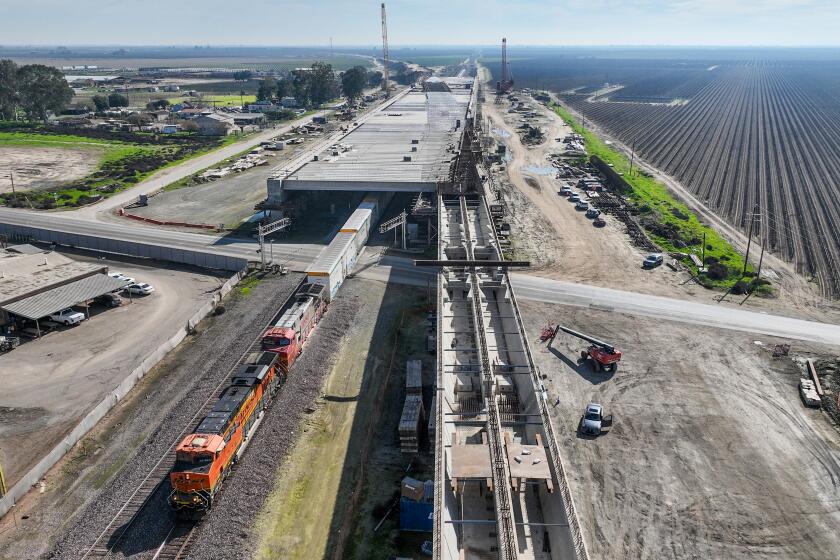2 airports, different directions
- Share via
While Santa Monica seeks to banish fast corporate jets from its much-contested airport, Hawthorne has rolled out a new asphalt carpet for them and other private planes.
Hawthorne Municipal Airport, a.k.a. Jack Northrop Field, has just completed a $5.5-million resurfacing of its runway, part of a $25-million renovation intended to entice new air traffic and add momentum to the revitalization of the east side of the 90,000-population municipality.
“This is a tale of two cities,” said Jeffrey Dritley of Kearny Real Estate Co., a partner in the renewal effort. “The Hawthorne community is very supportive of the airport, and Santa Monica isn’t. Hawthorne is encouraging new aviation, not trying to kick it out.”
The Santa Monica and Hawthorne airports are among the six designated “reliever” airports that take the pressure of private air traffic off Los Angeles International. The others are L.A. County-owned Whiteman Airport in Pacoima and Brackett Field in El Monte, and municipal airports Torrance/Zamperini Field and Compton/Woodley Airport.
With a projected 135,000 takeoffs and landings this year, Santa Monica Municipal Airport, in operation since 1919, is about twice as busy as Hawthorne, which opened in 1939. The two airports have runways of similar length, about 5,000 feet, and can accommodate aircraft of similar size. Each was the home base of an aircraft-building company: Santa Monica of Douglas Aircraft, and Hawthorne of Northrop Aircraft.
Hawthorne officials say their airport has certain advantages. Its runway approach passes over the parking lots of large discount stores. At the end of its runway are several blocks of commercial development. The airport is only a block from the 105 Freeway and 1 1/2 miles from the 405 Freeway.
The Santa Monica airport, by contrast, is in a high-cost residential area of congested surface streets. Some houses are a scant 300 feet from the runway. The airport sits atop a plateau with steeply sloping sides, and a recent city staff report likened landing there to putting down on an aircraft carrier. Complaints about engine noise and fears of aircraft crashing into houses are common themes in that city’s civic debate.
In January, the Santa Monica City Council will take a final vote on banning the fastest jets that use the airport, including such models as the $37-million Gulfstream IV and $20 million-plus Cessna Citation X. The council voted 7-0 in favor of such a ban in a preliminary vote in November, but the Federal Aviation Administration has vowed to fight it.
The Hawthorne redevelopers are betting that business jets are a vital part of the future of private aviation, as use of single-engine propeller planes continues declining from its heyday in the 1980s.
Hawthorne Mayor Larry Guidi said the faster jets have not been an issue among local residents.
“You don’t hear the new jets,” he said. “I know because I live right under the flight path. The noisy ones are the little, single-engine propeller jobs flying low.”
Dritley added that when the airport redevelopment plan underwent a series of public hearings, “there was almost no opposition. That’s got to be unique in the United States. People in the FAA were dumbfounded.”
Jose Gutierrez, president of the homeowners association of Holly Park, the residential area nearest the airport, said community reaction to the renovation has been generally positive.
“We hear more hum from the commercial jets on approach to LAX to the north of us than we do from the sporadic private aircraft that touch down at Hawthorne Airport,” he wrote in response to an e-mail requesting his comments. “The Hawthorne Airport has been good to us. No flights leave before 6 a.m. and no flights land after 6 p.m. during winter, and no later than 8 p.m. during summer.”
Significant socioeconomic and historical differences exist between seaside Santa Monica and workaday Hawthorne. Santa Monica is wealthy and mostly white and has a tradition of civic protest. Hawthorne is largely blue-collar and middle-class. In recent years, it has become increasingly Latino. These differences, Guidi said, help explain why the two cities have such divergent attitudes about their airports.
In 2001, Hawthorne residents voted 71% to 29% against a plan to close the long-neglected airport and develop the property for housing and other uses.
Hawthorne residents, especially those of long standing, consider the airport part of local history, Guidi said. Northrop founder “Jack Northrop came here, and many people will tell you, ‘My grandfather worked for Northrop,’ ‘My father worked for Northrop,’ ‘My uncles worked for Northrup.’ The airport was nostalgic for them, like the Beach Boys and Marilyn Monroe.”
For four years after the vote, however, nothing was done to improve the airport. Finally, Guidi approached Dritley’s company and its partner, Wedgewood Enterprises, about setting up a public-private arrangement for running the airport.
The partnership had its eye on 86 privately owned acres to the airport’s immediate south (they’re now the site of the partnership’s $150-million Century Business Center industrial park of new and renovated structures). The city agreed to lease all of the airport’s non-runway property to the partnership for 35 years in exchange for an annual payment that currently is $530,000.
The arrangement answered Guidi’s question about how to “find somebody else to pay the bills” at the airport.
To the partnership it offered a chance of “getting a leg up” on acquiring the acreage to the south, Dritley said. Moreover, Hawthorne was coming out of an economic swoon brought on by the shuttering of the Northrop manufacturing facilities in the 1990s.
“For us to get involved in a lot of things around here, that was a no-brainer for us,” Dritley said.
The partnership spent $1 million remodeling the airport’s terminal. It enlisted Million Air, a franchiser of upscale private aviation services, to provide a template for the redone facility, which is staffed by partnership employees.
Ripped carpeting repaired with duct tape, worn linoleum and stained chairs gave way to new stone floors, hotel-like restrooms, computer stations, a conference room and a luxurious pilots’ lounge with leather recliners and a large flat-screen television.
Construction is to begin next April on the first of 42 new hangars of various sizes.
Santa Monica Airport manager Robert Trimborn, who learned to fly at Hawthorne Airport and ran that facility from 1983 to 1993, said he did not believe the improvements would draw traffic from Santa Monica. “Aviation is like any other transportation system. People go where they want to go, because they want to go there, and a lot of people want to come to Santa Monica.”
Dritley said the Hawthorne partnership has been actively marketing its airport to private pilots and charter companies regardless of the airports they use.
The airport project is one of a number of developments transforming the city’s long-moribund east side. Next July, a Target store is to join the 3-year-old Lowe’s store across Crenshaw Boulevard from the airport. Also on the drawing board for that area is a gated community of 174 residences, to be called Central Park.
In January, the Century Business Center will become home to PayPal founder Elon Musk’s Space Exploration Technologies Corp., which is moving into a renovated 515,000-square foot facility formerly occupied by Northrop.
The redevelopers project that the Hawthorne field eventually will reach Santa Monica’s level of air traffic. Pilots encountering the redone airport for the first time have been impressed, said airport manager Bruce McCall. “Now we have pilots coming in here and being stunned,” he said.
---
More to Read
Inside the business of entertainment
The Wide Shot brings you news, analysis and insights on everything from streaming wars to production — and what it all means for the future.
You may occasionally receive promotional content from the Los Angeles Times.










